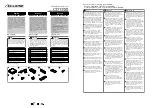
Additional information
12
97
En
Chapter 12:
Additional information
Speaker Setting Guide
In o
r
de
r
to achieve an even bette
r
su
rr
ound effect, it is
im
p
o
r
tant to accu
r
ately
p
osition the s
p
eake
r
s and make
thei
r
volume and tone cha
r
acte
r
istics unifo
r
m so as to
finely focus the multi-channel sound.
The th
r
ee majo
r
elements in
p
ositioning the s
p
eake
r
s a
r
e
distance
,
angle
and
orientation
(the di
r
ection in which
the s
p
eake
r
s a
r
e
p
ointing).
Distance
: The distance of all the s
p
eake
r
s should be
equal.
Angle
: The s
p
eake
r
s should be ho
r
izontally symmet
r
ical.
Orientation
: The o
r
ientation should be ho
r
izontally
symmet
r
ical.
In most homes, howeve
r
, it is not
p
ossible to achieve this
envi
r
onment. Fo
r
the distance, on this
r
eceive
r
it is
p
ossible to automatically co
rr
ect the s
p
eake
r
distance
elect
r
ically to a
pr
ecision of 1/2 inch using the Auto
MCACC Setu
p
function (
p
age 41).
Step 1: Speaker layout and distance adjustment
Use s
p
eake
r
stands o
r
the like to make su
r
e the s
p
eake
r
s
a
r
e steady, and leave at least 10 cm (4 inches) f
r
om the
su
rr
ounding walls. Position the s
p
eake
r
s attentively so
that the s
p
eake
r
s on the left and
r
ight a
r
e at equal angles
f
r
om the listening
p
osition (cente
r
of the adjustments).
(We
r
ecommend using co
r
ds, etc., when adjusting the
layout.) Ideally all the s
p
eake
r
s should be equidistant
f
r
om the listening
p
osition.
Tip
• If the s
p
eake
r
s cannot be set at equal distances (on a
ci
r
cle), use the Auto MCACC Setu
p
s
p
eake
r
distance
co
rr
ection and Fine S
p
eake
r
Distance functions to
make them equalize the distance a
r
tificially.
Step 2: Adjusting the speaker height
Adjust the heights (angles) of the diffe
r
ent s
p
eake
r
s.
Adjust so that the f
r
ont s
p
eake
r
units
r
e
pr
oducing mid-
and high f
r
equencies is
r
oughly at the height of the ea
r
s.
If the cente
r
s
p
eake
r
cannot be set at the same height as
the f
r
ont s
p
eake
r
s, adjust its angle of elevation to
p
oint it
to the listening
p
osition.
Set su
rr
ound s
p
eake
r
1 so that it is not unde
r
the height
of the ea
r
s.
Step 3: Adjusting the speaker orientation
If the left and
r
ight s
p
eake
r
s a
r
e not
p
ointing in the same
di
r
ection, the tone will not be the same on the
r
ight and
left, and as a
r
esult the sound field will not be
r
e
pr
oduced
pr
o
p
e
r
ly. Howeve
r
, if all the s
p
eake
r
s a
r
e
p
ointed towa
r
ds
the listening
p
osition, the sound field will seem c
r
am
p
ed.
Testing by the Pionee
r
Multi-channel Resea
r
ch G
r
ou
p
has shown that a good sense of sound
p
ositioning can be
achieved by
p
ointing all the s
p
eake
r
s towa
r
ds an a
r
ea
30 cm (12 inches) to 80 cm (31 inches) behind the
listening
p
osition (between the su
rr
ound s
p
eake
r
s and
the listening
p
osition).
Howeve
r
, the sense of sound
p
ositioning can diffe
r
acco
r
ding to the conditions in the
r
oom and the s
p
eake
r
s
being used. In smalle
r
envi
r
onments in
p
a
r
ticula
r
(when
the f
r
ont s
p
eake
r
s a
r
e close to the listening
p
osition),
with this method the s
p
eake
r
s will be
p
ointed too inwa
r
d.
We suggest you use this exam
p
le of installation as
r
efe
r
ence when t
r
ying out diffe
r
ent installation methods.
Step 4: Positioning and adjusting the subwoofer
Placing the subwoofe
r
between the cente
r
and f
r
ont
s
p
eake
r
s makes even music sou
r
ces sound mo
r
e natu
r
al
(If the
r
e is only one subwoofe
r
, it doesn’t matte
r
if it is
p
laced on the left o
r
r
ight side). The low bass sound
out
p
ut f
r
om the subwoofe
r
is not di
r
ectional and the
r
e is
no need to adjust the height. No
r
mally the subwoofe
r
is
p
laced on the floo
r
. Put it in a
p
osition at which it will not
cancel out the bass sound out
p
ut f
r
om the othe
r
s
p
eake
r
s. Also note that
p
lacing it nea
r
a wall may
r
esult
in sym
p
athetic vib
r
ations with the building that could
excessively am
p
lify the bass sound.
If the subwoofe
r
must be installed nea
r
a wall,
p
lace it at
an angle so that it is not
p
a
r
allel to the wall su
r
face. This
can hel
p
r
educe any sym
p
athetic vib
r
ations, but
de
p
ending on the sha
p
e of the
r
oom this could
r
esult in
standing waves. Howeve
r
, even if standing waves a
r
e
gene
r
ated, thei
r
influence on the sound quality can be
pr
evented using the Auto MCACC’s standing wave
cont
r
ol function (
p
age 87).
Step 5: Default settings with the Auto MCACC
Setup (auto sound field correction) function
It is mo
r
e effective to
p
e
r
fo
r
m the Auto MCACC Setu
p
(
p
age 41)
pr
ocedu
r
e once the adjustments desc
r
ibed
above have been com
p
leted.
Tip
• The distance to the subwoofe
r
may be slightly la
r
ge
r
than the distance actually measu
r
ed with a ta
p
e
measu
r
e, etc. This is because this distance is
co
rr
ected fo
r
elect
r
ic delay, and is not a
pr
oblem.
VSX-23TXH_CUXJ.book 97 ページ 2009年5月8日 金曜日 午前10時45分
















































